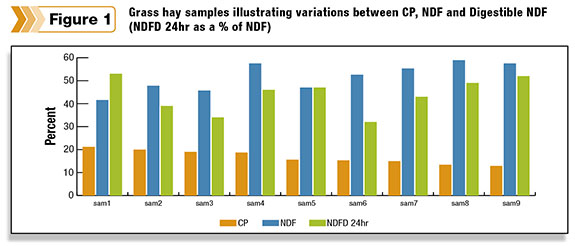The foundation of dairy cow nutrition is forage. Forage is the primary source of effective fiber in a cow’s diet and is essential for optimal rumen fermentation. Forage quality impacts feed intakes, cow health and, ultimately, milk production. In order for a forage be considered high-quality, it must be palatable and the fiber must be highly digestible.
The extent of the digestibility of a forage – how fermentable it is in the rumen – is highly correlated to the maturity of the forage prior to harvesting.
The more a plant matures – the longer it’s in the ground and growing – the more fibrous it becomes and, generally, both the protein level and the digestibility declines. As forages become more mature, cows’ abilities to consume those forages also decline.
Forage quality focuses on a fiber fraction known as neutral-detergent fiber (NDF), named for the laboratory process. In recent years, the digestibility of NDF fraction has become increasingly important in the balancing of dairy cow diets.
Research has shown that increasing NDF digestibility (NDFD) increases both dry matter intakes and milk production. The NDFD in forages is often a factor of growing conditions such as temperature, season and soil conditions.
Even though a forage may have a high NDF value, conditions while the plant was growing may influence how it’s treated in the rumen.
Generally speaking, forages lower in NDF are less mature and have higher levels of protein, both of which speak favorably for higher milk production. Most of the time the hay with a higher protein level is going to be the dairy farmer’s first choice.

Figure 1 compares nine samples of grass hay with varying crude protein (CP) levels (blue bars).
As would be expected, the NDF values (red bars) of the samples have a negative correlation to crude protein, and the trend is fairly linear. As CP declines, NDF increases.
However, the NDFD (white bars) for the samples are quite variable. (These NDFD values represent 24-hour in-vitro digestibility and are presented in the figure as a percentage of NDF.)
There is no predictable pattern of NDFD for this group of hay samples, which suggests that one cannot count on forages with high CP and lower NDF to necessarily always have a high NDF digestibility. The NDFD for these nine samples ranged from 32 to 56 percent, with some of the higher NDFD being associated with low-protein forages.
In order to be used in dairy ration balancing, the NDFD data is converted into another metric estimating the rate-of-passage (Kd) of the forages through the rumen. Cows are able to consume more of a forage that has a higher NDF digestibility and Kd rate.
Advanced ration balancing models essentially calculate the levels of microbes produced in the rumen – microbial protein – from increased forage digestibility. Even though there are a multitude of other factors influencing milk production, increasing rumen microbial protein often results in increased milk production.
Choosing between the samples 3 and 4 in Figure 1 poses an interesting situation. With the CP being nearly identical in each, there are significant differences in both NDF and NDFD.
Even though NDF is higher in sample 4, so is the NDFD. Which one of those two hays would be a better choice when CP is at a respectable level of around 18 percent for both?
Entering the relevant data into the Cornell-Penn-Miner ration balancing program, or CPM, showed that sample 3 had an advantage of only 1 pound of milk production over sample 4.
The software predicted that there would be about 50 more grams of metabolizable protein (MP) coming from rumen bacteria, while the MP coming from rumen-undegradable protein (RUP) remained nearly the same.
Even though the NDF was higher in sample 4, and that value by itself might cause us to dismiss the hay, the higher NDFD was able to support nearly as much milk as sample 3 did in spite of the fact that sample 3 has a lower NDF. This example illustrates that NDFD in forages is an important factor to be considered.
As dairy farmers look seriously at incorporating more forages into milk cow diets, knowing the quality of that forage becomes more critical.
The digestibility of fiber in forages does not follow any predictable pattern. Laboratory analysis for NDFD should be taken advantage of and used when evaluating forage purchasing decisions. PD

John Hibma
Nutritionist
Central Connecticut Co-operative Farms Association






